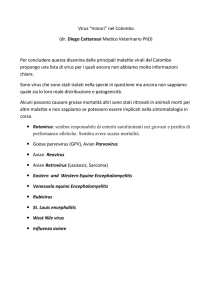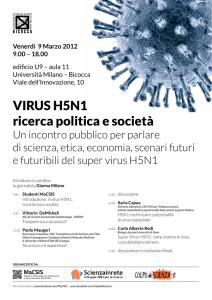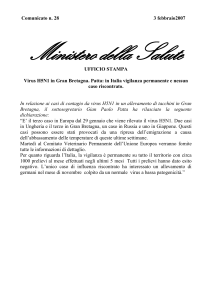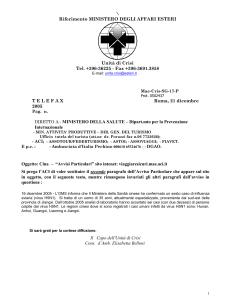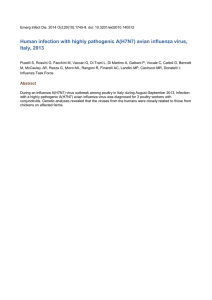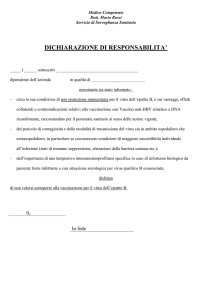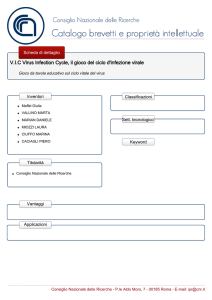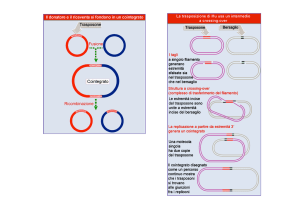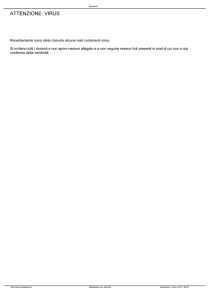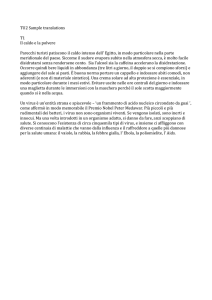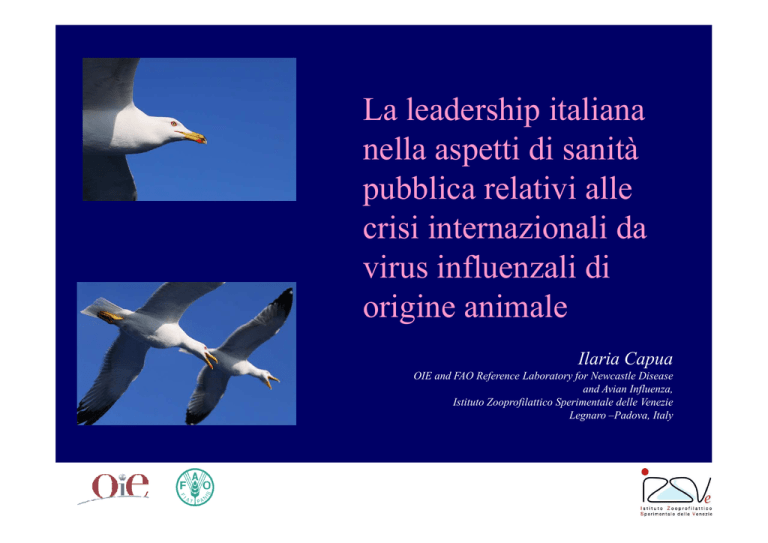
La leadership italiana
nella aspetti di sanità
pubblica relativi alle
crisi internazionali da
virus influenzali di
origine animale
Ilaria Capua
OIE and FAO Reference Laboratory for Newcastle Disease
and Avian Influenza,
Istituto Zooprofilattico Sperimentale delle Venezie
Legnaro –Padova, Italy
Fasi Pandemiche
Highly Pathogenic Avian Influenza,
Italy 1999-2000
Spanish influenza 1918-1919
20-40 million dead
Panzoozia H5N1- rilevanza
mondiale
• H5N1 è endemica in diversi
paesi (aree) del mondo
• Il virus è in grado di infettare
circa 50 specie di volatili e
oltre 10 specie di mammiferi
• Il virus contiene mutazioni
simili al virus della
“Spagnola”
• H5N1 sta riducendo la fonte
di proteine animali in alcuni
paesi in via di sviluppo
Raw duck blood pudding- Vietnam
Panzoozia H5N1
• Ad oggi ancora confinata agli animali con
eventi di trasmissione interumana sporadici
• Letalità di circa il 50% in @480 persone
infette
• Infezioni umane molto frequenti in
Indonesia ed in Egitto, particolarmente nei
bambini (recettori?)
Inizio 2006 – H5N1 raggiunge l’Africa
Prima incursione H5N1 in Africa
• L’Istituto Zooprofilattico Sperimentale delle
Venezie è stato il primo laboratorio al mondo a
isolare il virus H5N1 africano
• Lo studio delle caratteristiche genetiche del virus
potevano permettere una maggiore comprensione
dell’epidemiologia e patogenicità del virus
• Abbiamo declinato l’offerta di depositare la
sequenza genetica in un database ad accesso
limitato (accesso a solo 15 laboratori) e abbiamo
depositato l’intera sequenza in GenBank, un
database pubblico
MONDAY, MARCH 13, 2006
Scientist Rebels Against WHO Over Bird Flu
Scientists around the world, racing to discover how avian influenza is spreading and whether it is evolving
toward a pandemic strain, face a dilemma: Should they share their interim findings widely, show them only to
a select set of peers, or keep them to themselves until they can publish papers, often critical to their careers?
Now, a lone Italian researcher has cast a harsh spotlight on the WHO's system, suggesting that it places
academic pride over public health - and snubbing it by posting prized bird-flu data in plain view.
Ilaria Capua, a 39-year-old Italian veterinarian working on avian influenza in a
government lab, last month received a sample of the virus in the mail from Nigerian
health authorities. The virus had just attacked birds in Nigeria, the first confirmed
case of the disease in Africa. The sample was something of a prize, a chance to study
a specimen and explore how it spread from its stronghold in Asia.
Within days of isolating the virus, Dr. Capua says, she got an offer from a senior
scientist at the WHO in Geneva, whom she declined to name, to enter her finding in
the closed system. She could submit the virus's genetic information, or sequence, to
the database. In exchange, she would be given the password to the WHO's massive
stash of data. A spokesman for the WHO confirmed that the offer was made.
Instead, Dr. Capua posted the gene sequence in a public database accessible on the
Internet. She also sent a letter on Feb. 16 to around 50 of her colleagues urging them
to do the same with their bird-flu samples.
"If I had agreed" to the WHO's request, she said in an interview, "it would have been
another secret sequence."
EDITORIAL
Secret Avian Flu Archive
Published: March 15, 2006
At a time when health authorities are racing to head off a possible avian flu
pandemic, it is distressing to learn that the World Health Organization is
operating a secret database that holds the virus's genetic information. A lone
Italian scientist has challenged the system by refusing to send her own data
to the password-protected archive. Instead, she released the information
publicly and urged her colleagues to do the same. She is surely right. The
limited-access archive should be opened or bypassed immediately to
encourage research on this looming health menace.
The campaign by Ilaria Capua, an Italian veterinarian who works on avian
influenza, was spotlighted in recent articles in the journal Science and The
Wall Street Journal. The hidden data could be of immense value in
determining how the virus is evolving and in developing effective vaccines
or drugs. The possibility of breakthroughs can increase only if many more
scientists can analyze the data.
GISAID- Global Initiative
on Sharing Avian
Influenza Data
www.gisaid.org
Nature Correspondence 24 Aug, 2006
firmatari: 70 virologi medici e veterinari e
6 vincitori di premio Nobel
Database “open access”
gratuito che contiene le
sequenze geniche dei
virus influenzali umani
ed animali e protegge la
proprietà intellettuale
RESOLUTION No. XXVI
Sharing of avian influenza viral material and information
in support of global avian influenza prevention and control
• 1.
OIE Members reporting outbreaks of avian influenza should agree
to share animal avian influenza viral material and information about
avian influenza viruses through OFFLU with the international
scientific community.
• 2.
OIE Reference Laboratories must actively encourage sharing of
material and data with the international scientific community, and as a
minimum deposit genetic data within 3 months of receiving an
isolate into a public database designated by the OFFLU Steering
Committee, which will manage scientific relations with the WHO.
• 3. To enhance cooperation and transparency, the actions taken by
countries must be recognised in subsequent publications and other
benefits arising from the use of biological material or data that they
have submitted to OIE Reference Laboratories.
http://apps.who.int/gb/ebwha/pdf_files/A62/A62_5Add1-en.pdf
~ 1998
PB2,PA:
Triple reassortant
~ 1968
~ 1998
PB1:
~ 1918
HA, NP, NS:
~ 1979
NA, MA:
Geni provenienti da:
• virus di 3 specie
•due emisferi
Classical swine
Eurasian swine
A/California/4/2009
PB2
PB1
PA
HA
NP
NA
MA
NS
Banca dati GISAID- EpiFlu DB
E’ stata riconosciuta pubblicamente dal vice
direttore dell’OMS come strumento
essenziale per la tempestiva identificazione
e caratterizzazione del virus pandemico
A/H1N1/2009. Viene utilizzata a tutt’oggi
per seguire l’evoluzione virale a livello
globale.
“One Health”
L’unione fa la forza,
soprattutto in sanità
pubblica
Una riflessione
Premio Scientific
American 50 assegnato
ai 50 ricercatori migliori
dell’anno
Bird Flu Research for All
Until recently, laboratories doing bird flu research often kept their findings private, with access to
many avian influenza gene sequences confined to just 15 facilities globally, potentially hindering them
from doing research that could provide new insight into the virus. Instead of entering her avian
influenza findings into this database, Ilaria Capua of Viale University in Padua, Italy, disclosed the
results of her studies in the publicly accessible GenBank and boldly rallied her colleagues to follow.
Her efforts helped to pave the way for the Global Initiative on Sharing Avian Influenza Data, a
consortium through which findings can be freely shared while giving credit to researchers involved.
—Charles Q. Choi
Una delle 5 “Revolutionary Minds”
della rivista americana SEED
Riconoscimento internazionale
Alla rete degli IIZZSS ed al servizio
sanitario nazionale, per il loro ruolo a
tutela della sanità pubblica
internazionale
INFLUENZA A H1N1
Tra Dubbi e Certezze … Istruzioni per l’Uso
(Evento ECM n 9034799)
Venerdì 18 settembre 2009 ore 08.30 – 17.00
COMUNE DI ROMA
Palazzo Senatorio- Aula Giulio Cesare
P.zza del Campidoglio - Roma
LA LEADERSHIP ITALIANA SUGLI ASPETTI DI SANITA’ PUBBLICA INTERNAZIONALE
RELATIVI AI VIRUS INFLUENZALI DI ORIGINE ANIMALE
Dott.ssa Ilaria Capua
Centro di Referenza Nazionale OIE/FAO sull’Influenza aviaria e Centro di Collaborazione
sulle malattie infettive nell’interfaccia uomo-animale.
Istituto Zooprofilattico Sperimentale delle Venezie
La Sanità pubblica veterinaria italiana ha avuto un ruolo cardine nella gestione delle
crisi internazionali causate dai virus influenzali animali, costruendo e capitalizzando
sull’esperienza maturata a livello nazionale e sulle competenze degli Istituti Zooprofilattici
Sperimentali (IIZZSS).
In collaborazione con il Ministero della Salute, gli IIZZSS hanno affrontato e gestito
epidemie nel pollame domestico e negli uccelli selvatici a partire dal 1997.
Successivamente all’epidemia di influenza aviaria ad alta patogenicità che nel 19992000 provocò morte di 17 milioni di volatili, gli IIZZSS hanno sviluppato progetti di ricerca
nazionali ed internazionali, i cui risultati hanno contribuito all’aumento della conoscenza
in ambito internazionale in questo campo.
Infatti, è stato grazie alla ricerca svolta in Italia che è stata sviluppata una strategia di
vaccinazione per l’influenza aviaria approvata e condivisa dall’Unione Europea,
dall’Organizzazione Mondiale per la Sanità Animale e dalla FAO, oggi proposta a livello
internazionale come strumento di lotta al virus H5N1.
Inoltre, la rete degli IIZZSS italiani ha contribuito in maniera essenziale e strategica
alla gestione globale delle crisi internazionali da H5N1 e da H1N1. Nel febbraio 2006, i
virologi degli IIZZSS italiani non hanno esitato a depositare le sequenze genetiche dei
virus H5N1 isolati in Italia in un database pubblico, permettendo a ricercatori di tutto il
mondo di avere accesso ad informazioni sull’epidemiologia molecolare del virus H5N1
(1,2).
Inoltre il Centro di Referenza Nazionale, presso l’Istituto Zooprofilattico Sperimentale
delle Venezie, a Legnaro, (PD), si è fatto promotore a livello internazionale dell’iniziativa
GISAID sulla trasparenza dei dati sui virus influenzali, sottoscritto da 70 virologi medici e
veterinari di tutto il mondo e da 6 vincitori di premio Nobel (3).
L’iniziativa GISAID si è rivelata di importanza cruciale anche nell’emergenza globale
causata dal virus H1N1 di origine suina.
È, infatti, grazie a questa piattaforma informatica che è stato possibile decifrare il
genoma del virus emerso dal serbatoio suino in tempo reale. La piattaforma GISAID
rappresenta oggi un esempio unico di collaborazione transdisciplinare, soprattutto fra
virologi medici e veterinari essenziale per la ricerca nel campo delle malattie che
emergono dal serbatoio animale.
La rete degli IIZZSS è parte integrante del Servizio Sanitario Nazionale ed oltre a
svolgere i compiti istituzionali, rappresenta una risorsa a supporto delle emergenze
sanitarie sia a livello nazionale che internazionale.
Bibliografia
1. Salzberg S.L., Kingsford C., Cattoli G., Spiro D.J., Janies D.A., Aly M.M., Brown I.H., CouacyHymann E., De Mia G.M., Dung D.H., Guercio A., Joannis T., Ali M.S.A., Osmani A., Padalino I., Saad
D.M., Savic V., Sengamalay A.N., Yingst S., Zaborsky J., Zorman-Rojs O., Ghedin E., Capua I.
(2007). “Genome analysis linking recent European and African influenza (H5N1) viruses”; Emerging
Infectious Diseases, Vol. 13(5), pp. 713-718
2. Capua I., Brown I., Johnson M., Senne D., Swayne D. (2006). “Veterinary virologists share avian
flu data”, Science, (June 2006), Vol. 312, p. 1597
3. Bogner P., Capua I., Lipman D.J., Cox N.J. and others (2006). “A global initiative on sharing avian
flu data -GISAID”, Nature, Vol. 442, p. 981

